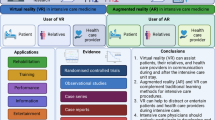Abstract
When working on any informatics topic, it is critical to understand the primary mechanism of the domain. This is no different in bioinformatics, which necessitates a fundamental grasp of the biological phenomena under consideration. Understanding biological phenomena, on the other hand, is not always easy since the intricacy of the events and the difficulty in picturing the events can often lead to difficulties in gaining insight, which is especially important in education. For teaching purposes, many biological processes are shown in written and visual form. New technologies such as virtual reality (VR) and mixed reality (MR) are occasionally used to increase the efficacy and ease of use of the training. In this study, a 3D interactive simulation of white blood cells, one of the body’s defense system components, battling bacteria in a blood artery, was used. Twenty-two participants tested the interactive demonstration of how these cells function in Personal Computer (PC), VR, and MR settings, and an answer to which platform was favored for this sort of visualization was sought. The findings highlight the potential of such interactive experiences, in which participants effectively evaluate usability, immersion, and presence.
Access this chapter
Tax calculation will be finalised at checkout
Purchases are for personal use only
Similar content being viewed by others
Notes
- 1.
White Blood Cell Differential Simulator, https://www.medialab.com/case-simulator-wbc, Last accessed: 2023–04-30.
- 2.
Smoldyn. (n.d.). Home - Smoldyn. Retrieved from https://www.smoldyn.org/.
- 3.
Unity Real-Time Development Platform, https://unity.com, Last accessed: 2023–04-30.
- 4.
About Splines, https://docs.unity3d.com/Packages/com.unity.splines@2.0/manual/index.html, Last accessed: 2023–04-30.
- 5.
Creator Kit: FPS, https://assetstore.unity.com/packages/templates/tutorials/creator-kit-fps-149310, Last accessed: 2023–04-30.
- 6.
Map Controllers | Oculus Developers, https://developer.oculus.com/documentation/unity/unity-ovrinput/, Last accessed: 2023–04-30.
- 7.
Blender.org | Home of the Blender project, https://www.blender.org/, Last accessed: 2023–04-30.
References
Chi, S., Wang, Z., Liu, X., Zhu, L.: Associations among attitudes, perceived difficulty of learning science, gender, parents’ occupation and students’ scientific competencies. Int. J. Sci. Educ. 39(16), 2171–2188 (2017)
Pigozzo, A.B., Macedo, G.C., Dos Santos, R.W., Lobosco, M.: On the computational modeling of the innate immune system. BMC Bioinform. 14, 1–20 (2013)
Harb, A., Fakhreddine, M., Zaraket, H., Saleh, F.A.: Three-dimensional cell culture models to study respiratory virus infections including COVID-19. Biomimetics 7(1), 3 (2022)
Marino, S., Hogue, I.B., Ray, C.J., Kirschner, D.E.: A methodology for performing global uncertainty and sensitivity analysis in systems biology. J. Theor. Biol. 254(1), 178–196 (2008)
Zhang, J.F., Paciorkowski, A.R., Craig, P.A., Cui, F.: BioVR: a platform for virtual reality assisted biological data integration and visualization. BMC Bioinform. 20, 1–10 (2019)
Wu, H.K., Lee, S.W.Y., Chang, H.Y., Liang, J.C.: Current status, opportunities and challenges of augmented reality in education. Comput. Educ. 62, 41–49 (2013)
Bower, M., Howe, C., McCredie, N., Robinson, A., Grover, D.: Augmented reality in education–cases, places and potentials. Educ. Media Int. 51(1), 1–15 (2014)
Cassidy, K.C., Šefčík, J., Raghav, Y., Chang, A., Durrant, J.D.: ProteinVR: web-based molecular visualization in virtual reality. PLoS Comput. Biol. 16(3), e1007747 (2020)
Mazurek, J., et al.: Virtual reality in medicine: a brief overview and future research directions. Human Movement 20(3), 16–22 (2019)
Yeung, A.W.K., et al.: Virtual and augmented reality applications in medicine: analysis of the scientific literature. J. Med. Internet Res. 23(2), e25499 (2021)
Amini, H., et al.: Feasibility and usability study of a pilot immersive virtual reality-based empathy training for dental providers. J. Dent. Educ. 85(6), 856–865 (2021)
Segal, A.W.: Europe PMC funders group how neutrophils kill microbes. Ann. Rev. Immunol. 2 (2007)
Janeway, C.A., Travers, P., Walport, M., Shlomchik, M.J.: Immunobiology: The Immune System in Health and Disease, 5th edn. Garland Science, New York, NY (2001)
Venkatesh, V., Davis, F.D.: A theoretical extension of the technology acceptance model: four longitudinal field studies. Manage. Sci. 46(2), 186–204 (2000)
Brooke, J.: SUS-A quick and dirty usability scale. Usability Eval. Ind. 189(194), 4–7 (1996)
Witmer, B.G., Singer, M.J.: Measuring presence in virtual environments: a presence questionnaire. Presence 7(3), 225–240 (1998)
Jerome, C.J., Witmer, B.: Immersive tendency, feeling of presence, and simulator sickness: formulation of a causal model. In: Proceedings of the Human Factors and Ergonomics Society Annual Meeting, vol. 46. no. 26, pp. 2197–2201. SAGE Publications Los Angeles (2002)
Andrews, S.S., Addy, N.J., Brent, R., Arkin, A.P.: Detailed simulations of cell biology with smoldyn 2.1. PLoS Comput. Biol. 6(3), e1000705 (2010)
Ghaffarizadeh, A., Heiland, R., Friedman, S.H., Mumenthaler, S.M., Macklin, P.: PhysiCell: an open source physics-based cell simulator for 3-D multicellular systems. PLoS Comput. Biol. 14(2), e1005991 (2018)
Author information
Authors and Affiliations
Corresponding author
Editor information
Editors and Affiliations
Rights and permissions
Copyright information
© 2024 ICST Institute for Computer Sciences, Social Informatics and Telecommunications Engineering
About this paper
Cite this paper
Kaya, H.T., Surer, E., Acar, A.C. (2024). 3D Simulation and Comparative Analysis of Immune System Cell Micro-Level Responses in Virtual Reality and Mixed Reality Environments. In: Coelho, P.J., Pires, I.M., Lopes, N.V. (eds) Smart Objects and Technologies for Social Good. GOODTECHS 2023. Lecture Notes of the Institute for Computer Sciences, Social Informatics and Telecommunications Engineering, vol 556. Springer, Cham. https://doi.org/10.1007/978-3-031-52524-7_5
Download citation
DOI: https://doi.org/10.1007/978-3-031-52524-7_5
Published:
Publisher Name: Springer, Cham
Print ISBN: 978-3-031-52523-0
Online ISBN: 978-3-031-52524-7
eBook Packages: Computer ScienceComputer Science (R0)




